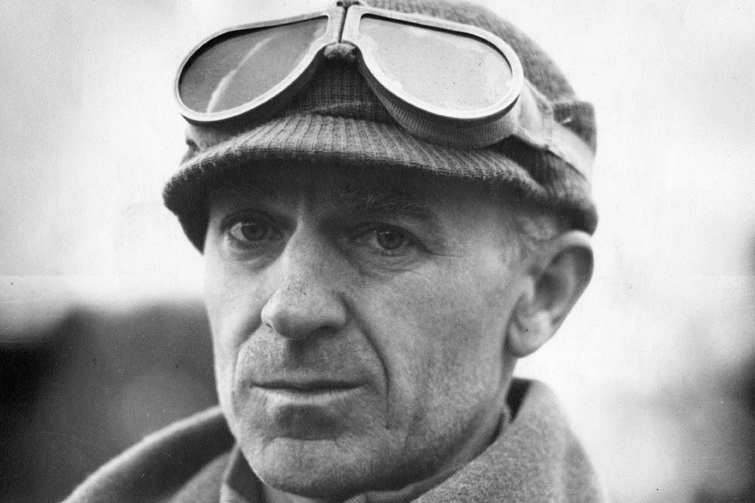
Ernie Pyle: Life in the Trenches airs Monday, June 1 at 9:30pm on WTIU. We talked with producer Todd Gould about his experience filming the documentary and Ernie Pyle's legacy.
What was it like to profile someone of Ernie Pyle’s fame and stature? What steps did you take to make sure you got his story right?
I've always been a fan of stories that take root in Indiana, but upon further reflection, quickly grow so far-reaching in scope and content. Ernie Pyle was one such character study. His early years in Indiana were a launching pad to a life and career that spanned the entire United States (during his early years as a columnist in Washington, D.C.) and then to the far-reaching corners of the globe through his celebrated war reporting during WWII. By the end of the war, he was the most widely published newspaper columnist in America. The thing that made Pyle's writing so special was that he gained great acclaim for writing not about famous people, but rather writing about the extraordinary efforts of ordinary Americans. This really resonated with his readers during two of the darkest chapters in the 20th century—the Great Depression and World War II. Pyle's columns gave readers characters that they could easily relate to and celebrate for instilling hope and achieving the kinds of things that so many "common heroes" were accomplishing. That spirit still resonates today. We read so many articles today and watch so many segments on TV of all these"essential workers that deserve our thanks during this pandemic—ordinary folks who continue to do extraordinary things during trying times. It was in this same spirit that Pyle wrote his most famous works during the 1930s and '40s. That style still means so much to people today, just as it did during Pyle's day.
In order to get the story right, we spent more than ten years researching many of Pyle's original writings...not only his columns, but also letters and telegrams between the author and his family, friends, work colleagues, and others, which were all so very revealing about the "man behind the moniker." So much of this personal correspondence revealed much of what Pyle was thinking, even as he was presenting "Ernie Pyle, the Persona" to the public each day in his newspaper columns. These personal letters, along with first-person interviews with those who worked and lived alongside Pyle, gave a much deeper, richer portrait of what "Ernie Pyle, the Man" was really like behind the fame and prestige. Our ability to work alongside noted historians and archivists, especially the experts at the Indiana State Museum, who care for thousands of articles within the Ernie Pyle archives, was extraordinarily helpful throughout the research and writing process.
Tell us how Dan Rather and Jonathan Banks became involved in the documentary.
I really could not have imagined having anyone more appropriate than Rather and Banks as the principal narrators within the documentary. Of course, Dan Rather's fame and reputation as one of America's leading war correspondents during the Vietnam War (in his days prior to serving as the lead anchor for the CBS Evening News) really stood out. In our opinion, he was THE most appropriate and most distinguished narrator for a documentary on Ernie Pyle as the nation's top reporter and correspondent during WWII. Rather was also a big fan of Pyle's writings, and when we reached out to him to gauge his interest in the documentary, he responded right away: "How can I help?" Working with him was a true joy, as Rather was a hero of mine growing up as a young journalism student. His interest and passion for the subject resonated throughout his performance in the documentary...and in his personal joy and passion for the project. He could not have been nicer—and (it probably goes without saying)—a real pro.
Banks was a fortunate find as the voice of Ernie Pyle in the documentary. Those who have studied Pyle extensively know that the Hoosier writer might have appeared meek and mild to the casual observer, but in reality, the diminutive journalist was an ornery, rough talking, hard-drinking, heavy-smoking character. I often joked that to find the perfect voice of Pyle we needed someone with a whiskey-stained tone to his voice. I've been a fan of Jonathan's for many years through his ongoing work as the resident tough guy on both the Breaking Bad and Better Call Saul series. As it turns out, Jonathan not only had ties back to Indiana University (where he was a student in the theatre department during the 1970s). He was also a big fan of Ernie Pyle's writings. Through a friend of a friend, word got to Jonathan that I was interested in having him read many of Pyle's writings in the documentary. Then, out of the blue, one weekend he reached me on my cell phone, introduced himself, and said that he would be honored and delighted to serve as the voice of Pyle. My dream had come true! Two of the biggest talents in their respective fields lending their skills to this important documentary project. I could not have been more fortunate. And the quality of the documentary speaks to their extraordinary gifts. We were thrilled.
About how long did the researching and producing process take?
Some of the earliest research on Pyle began more than 15 years ago. Early in the process, I had an opportunity to interview several contemporaries and colleagues of Pyle's, including the late great Walter Cronkite (of the CBS Evening News) and Andy Rooney (acclaimed commentator on 60 Minutes). Both of these distinguished newsmen cut their teeth with Pyle in the press corps and worked alongside him during World War II. At that time, we also had an opportunity to interview several veterans of the War who served in various divisions whom Pyle visited and wrote about during many of his war columns. Several of these vets remembered how they unknowingly became subjects in several of Pyle's columns, which often turned them into mini-celebrities within their units overseas, and certainly among friends and family back home in the U.S. Hearing many of their tales of personal heroism during the war were so compelling. It was easy to see why Pyle found their personal stories so gripping back in the 1940s. Their memories are just as powerful hearing them 60 to 70 years later.
Much of the most intense research and writing took place over the past two years, as our production crew traveled to several battle sites throughout Europe where Pyle wrote his most memorable columns. Much of the terrain and ruins around these sites had changed little since the battles that tore through those lands in England, France, and Italy back in the 1940s. Hiking through those grounds today and re-reading many of Pyle's columns really helped bring the research home in a way that could scarcely be imagined by simply reading about the battles in some textbook. We were fortunate (and so very thankful to our program funders) for helping to support our film crew with the resources necessary to help tell the story not only of Pyle, but also the Allied soldiers he spotlighted so eloquently in his columns.
What was your favorite part of producing Ernie Pyle: Life in the Trenches?
Having had the opportunity to travel to many of those old WWII battle sites in places like Anzio, Rome, San Pietro, London, Paris, and the Normandy coastline really helped provide the needed color and texture to better understand what the Allied forces were facing during the bloodiest war in world history to that point. And it helped us better understand the trials and triumphs that Pyle was attempting to spotlight in his daily columns to those back on the homefront.
As well, having had the opportunity to read many of Pyle's personal letters and telegrams from family, friends and colleagues gave me tremendous insight into the inner thinking of Pyle and a better understanding of his complicated relationships. Hopefully, some of these insights shine through in the telling of Pyle's story in this documentary.
Probably the most interesting part of the entire production process for me, however, was having the opportunity to talk one-on-one with several veterans from World War II to hear of their amazing stories of courage and hope. Pyle was not one to write about the generals and the political leaders. His beat was following the trail of the common foot soldiers who were doing all the fighting and bleeding and dying to ward off the Axis forces and secure peace worldwide. The one thing that impressed me most was their commitment—not so much to pageantry and patriotism—but rather to each other. The solemn commitment to their fellow brothers-in-arms was such a powerful notion that kept these men (and women) going amid some of the most horrifying events in history. Their bonds to one another were, as one soldier in the documentary put it, "stronger than a marriage." I found that notion not only consistent among these soldiers, but also compelling in how it played out in this most dramatic of times.
Some journalists today speak of this era as "the Good War." To a man, no one I talked with ever considered the events of World War II a "good war." A "necessary war?" All absolutely agreed that this was true. But a "good war." No. The only thing that made it "good" in their opinion was how the war brought them together as brothers. That is what will always stick in their minds. And having had the opportunity to write and produce this documentary, this was, to me, the most compelling part of the entire storytelling process. True brothers in arms. What a powerful concept.
What do you hope viewers take away or learn from the documentary?
One of my biggest hopes I have for the documentary is allowing viewers to come to a greater understanding and appreciation of Pyle's writing skills. His writing style was conversational and colloquial, and if one only looks at the surface of Pyle's writing, they might see this as a rather simple style of conversational journalism. In fact, he labored intensely to create the image of the story and the storyteller as a "friendly, front porch neighbor." This storyteller could weave together effective tales that took readers on little journeys with subjects who shared their interests, passions, and values. Pyle could use a turn of phrase or a short anecdote to guide readers on these little daily odysseys that were always relatable and resonated with each of them on a personal level. That's what made his columns so popular among millions of readers.
By the time he began his coverage of the war, Pyle was already a seasoned veteran of telling the tales of ordinary Americans doing extraordinary things. Whether it was a gas station attendant in Omaha, Nebraska, or a private from California serving with the infantry in France, the subjects of Pyle's stories were always folks everyone could relate to and celebrate in ways that seemed familiar and comfortable with the readers themselves and their families.
The notion of embedded journalists who spent extensive time with soldiers at the front lines was not a new concept at the start of World War II. Reporters have been marching alongside soldiers in battle since the dawn of our nation. But perhaps no one cultivated the notion of embedded journalism in quite the same way that Ernie Pyle did. While most war reporters spent their days covering the latest word from the general's headquarters, Pyle always insisted on serving alongside the frontline soldiers and telling their stories of uncommon heroism. It was the same "front porch storytelling" that he had molded to perfection over his years as a Pulitzer Prize-winning columnist back home. There was perhaps no greater reporter of the war as it influenced the soldiers themselves and their families back home. And that is why Ernie Pyle has earned the legacy as "America's storyteller."







